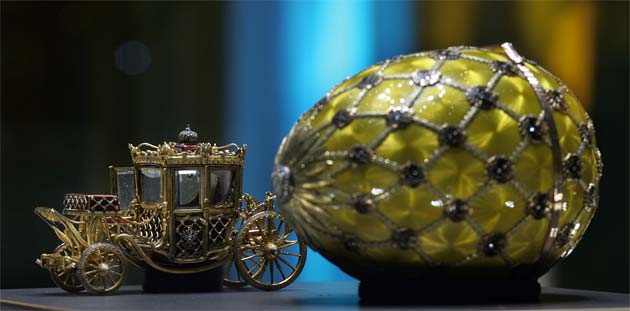- Home
- Internet
- Internet News
- All about Peter Carl Faberge eggs
All about Peter Carl Faberge eggs
By Rohan Madhav Modwel | Updated: 5 June 2012 10:47 IST

Click Here to Add Gadgets360 As A Trusted Source

Advertisement
One cannot deny that the Faberge egg is commonly known to many people around the world. However, only the tiniest percentage of these would probably know how and where they even came from.
Featuring in the latest Google Doodle on account of Peter Carl Faberge's 166th birthday, the Faberge's egg is, at the very least, a rare gem in today's world.
Indeed, it was the Russian, Peter Carl Faberge who, in the year 1885, produced the first imperial egg.
Interestingly, this beautifully simple egg opened up to reveal a yolk. Inside the yolk was a golden hen and inside the hen was a diamond miniature of the crown as well as a tiny ruby egg. Faberge was a court supplier to the last two Russian Czars, and hence, presented this egg as a gift to the Czarina Maria, wife of the Czar Alexander III. As it reminded her of her home, a new egg was commissioned by the Czar and created by Faberge for the Czarina each year thereafter.
Hence began the tradition of gifting an egg each year to the Czarina during the Russian Orthodox Easter festival. The eggs became more and more elaborate, and each one contained a hidden treasure within. This tradition was also taken up by the Czar's successor, Nicholas II. A total of 50 imperial eggs were made for Russian czars, but only 42 have survived.
In order to create these precious eggs, Faberges used various metals - silver, gold, copper, nickel, palladium - that were combined in varying proportions to produce different colors. Another technique used by Faberges included guilloche, a surface treatment that could make waves and striations in the design, either by machine or by hand. Faberge used natural stones that were found in abundance in the area. These included jasper, bowenite, rhodonite, rock crystal, agate, aventurine quartz, and jade. Precious stones including diamonds, sapphires, rubies and emeralds were used only for decoration.
One spectacular egg, in particular, is the Azova Egg, which is named for its surprise - a fantastically detailed model of a ship of gold and platinum, which is point precise, all the way down to the tiny windows made of diamonds. Another one is the Renaissance Egg, which is one of the few eggs displayed on its side rather than stood on one end. Other famous eggs are the Coronation Egg, the Czarevich Egg, the Gold Pelican Egg, and the Resurrection Egg.
Featuring in the latest Google Doodle on account of Peter Carl Faberge's 166th birthday, the Faberge's egg is, at the very least, a rare gem in today's world.
Indeed, it was the Russian, Peter Carl Faberge who, in the year 1885, produced the first imperial egg.
Interestingly, this beautifully simple egg opened up to reveal a yolk. Inside the yolk was a golden hen and inside the hen was a diamond miniature of the crown as well as a tiny ruby egg. Faberge was a court supplier to the last two Russian Czars, and hence, presented this egg as a gift to the Czarina Maria, wife of the Czar Alexander III. As it reminded her of her home, a new egg was commissioned by the Czar and created by Faberge for the Czarina each year thereafter.
Hence began the tradition of gifting an egg each year to the Czarina during the Russian Orthodox Easter festival. The eggs became more and more elaborate, and each one contained a hidden treasure within. This tradition was also taken up by the Czar's successor, Nicholas II. A total of 50 imperial eggs were made for Russian czars, but only 42 have survived.
In order to create these precious eggs, Faberges used various metals - silver, gold, copper, nickel, palladium - that were combined in varying proportions to produce different colors. Another technique used by Faberges included guilloche, a surface treatment that could make waves and striations in the design, either by machine or by hand. Faberge used natural stones that were found in abundance in the area. These included jasper, bowenite, rhodonite, rock crystal, agate, aventurine quartz, and jade. Precious stones including diamonds, sapphires, rubies and emeralds were used only for decoration.
One spectacular egg, in particular, is the Azova Egg, which is named for its surprise - a fantastically detailed model of a ship of gold and platinum, which is point precise, all the way down to the tiny windows made of diamonds. Another one is the Renaissance Egg, which is one of the few eggs displayed on its side rather than stood on one end. Other famous eggs are the Coronation Egg, the Czarevich Egg, the Gold Pelican Egg, and the Resurrection Egg.
Comments
Catch the latest from the Consumer Electronics Show on Gadgets 360, at our CES 2026 hub.
Related Stories
Popular on Gadgets
- Samsung Galaxy Unpacked 2025
- ChatGPT
- Redmi Note 14 Pro+
- iPhone 16
- Apple Vision Pro
- Oneplus 12
- OnePlus Nord CE 3 Lite 5G
- iPhone 13
- Xiaomi 14 Pro
- Oppo Find N3
- Tecno Spark Go (2023)
- Realme V30
- Best Phones Under 25000
- Samsung Galaxy S24 Series
- Cryptocurrency
- iQoo 12
- Samsung Galaxy S24 Ultra
- Giottus
- Samsung Galaxy Z Flip 5
- Apple 'Scary Fast'
- Housefull 5
- GoPro Hero 12 Black Review
- Invincible Season 2
- JioGlass
- HD Ready TV
- Laptop Under 50000
- Smartwatch Under 10000
- Latest Mobile Phones
- Compare Phones
Latest Gadgets
- Honor Win RT
- Honor Win
- Xiaomi 17 Ultra Leica Edition
- Xiaomi 17 Ultra
- Huawei Nova 15
- Huawei Nova 15 Pro
- Huawei Nova 15 Ultra
- OnePlus 15R
- Asus ProArt P16
- MacBook Pro 14-inch (M5, 2025)
- OPPO Pad Air 5
- Huawei MatePad 11.5 (2026)
- Xiaomi Watch 5
- Huawei Watch 10th Anniversary Edition
- Acerpure Nitro Z Series 100-inch QLED TV
- Samsung 43 Inch LED Ultra HD (4K) Smart TV (UA43UE81AFULXL)
- Asus ROG Ally
- Nintendo Switch Lite
- Haier 1.6 Ton 5 Star Inverter Split AC (HSU19G-MZAID5BN-INV)
- Haier 1.6 Ton 5 Star Inverter Split AC (HSU19G-MZAIM5BN-INV)
© Copyright Red Pixels Ventures Limited 2025. All rights reserved.

















